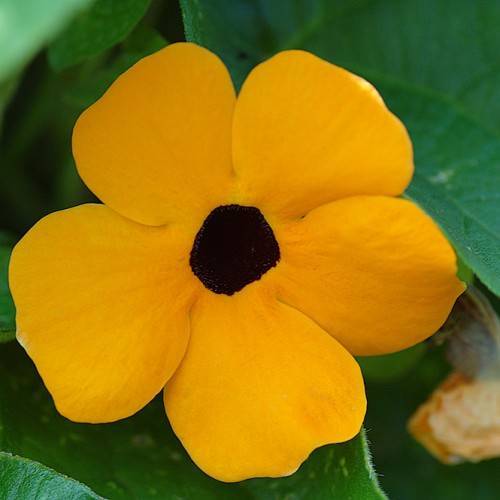
black-eyed Susan
Thunbergia alata 'Orange Wonder'
Cycle:
Perennial
Watering:
Average
Hardiness Zone:
10 - 11
Flowers:
Flowers In Summer
Sun:
full sun,part sun/part shade
Soil:
Well-drained
Fruits:
Fruits In Autumn Ready In Summer
Leaf:
Yes
Growth Rate:
High
Maintenance:
Moderate
Drought Tolerant:
Yes
Tropical:
Yes
Care Level:
Medium
watering
Black-eyed Susan (Thunbergia alata 'Orange Wonder') requires regular watering, particularly during the growing season. During the summer months, it is best to water it on a weekly basis. When watering, make sure to water deeply, until moisture comes out of the drainage holes at the bottom of the pot. In the winter months, reduce the frequency of watering to every 2-3 weeks, ensuring the soil has dried out between sessions.
sunlight
Black-eyed Susan (Thunbergia alata 'Orange Wonder') should receive 6 to 8 hours of direct sunlight each day in order to grow and thrive. Ideally, the plant should receive at least 4 hours of sunlight in the morning and up to 4 hours of sunlight in the afternoon. Morning and late afternoon sun are best for Black-eyed Susan.
pruning
For healthy growth, black-eyed Susans should be pruned twice a year, once in the spring after the plant has finished flowering, and again in the early fall. When pruning, remove any dead, diseased, or damaged foliage. Cut back the remaining branches by anywhere from 1-third to 1-half of their current length. When pruning in the spring, make sure to pinch off the flower buds as well to encourage the plant to continue producing healthy blooms throughout the growing season.
Propagation
Season
Hardiness Map
FAQ
Is Black-Eyed Susan a native plant?
Yes, Black-Eyed Susan is a native plant. It is native to the United States and Canada and is an annual wildflower found in grassy meadows, fields, and along roadsides. It is also known as the yellow ox-eye daisy and is most commonly found in the east side of the U.S.. It has a bright golden-yellow flower head and is one of the most common wildflowers in North America, blooming in the summer months of June to September. Black-Eyed Susan also attracts pollinators such as bees, butterflies, and hummingbirds.
Should Black-Eyed Susan flowers be deadheaded?
Yes, Black-Eyed Susan flowers should be deadheaded in order to keep them looking their best and promote a long blooming period. Deadheading is the process of removing faded flowers and spent seed heads from the plant. Doing this encourages the plant to produce more flowers and prevents it from focusing energy on producing seeds. Deadheading also helps to keep the plant looking bushy and prevents it from becoming leggy.
Are Black-Eyed Susan flowers suitable for cut arrangements?
Yes, Black-Eyed Susan flowers are a suitable choice for cut arrangements. They are a popular choice for providing bright, cheerful colour in gardens, and can be used indoors in floral arrangements. They are an easy to manage, low maintenance option given that they grow quickly without much fuss. The stunning daisy like flowers have a firm yet delicate texture, making them perfect for a wide range of uses. These beautiful and cheerful blooms can be used to brighten up any bouquet or centerpiece.
Do Black-Eyed Susan flowers require a trellis or support?
Black-eyed Susan flowers do not require a trellis or support as they have long, strong stems that can stand up on their own when mature. Furthermore, the strong stems and light flowers of the Black-eyed Susan make them one of the most wind-tolerant varieties of flower. However, if you do choose to support them with a trellis, they will likely need to be tied to the structure as their stems are quite flexible. Additionally, most trellises can help to encourage the tall, upright growth of these flowers.
Is Black-Eyed Susan a good choice for a butterfly garden?
Yes, Black-Eyed Susan (Rudbeckia hirta) is an excellent choice for a butterfly garden. Highly attractive to butterflies and other pollinators, the Black-Eyed Susan provides a food source and a landing pad for them. This perennial's bright yellow-orange flowerheads appear from midsummer into early fall, making for a highly attractive addition to a butterfly garden. The Black-Eyed Susan is low maintenance and requires minimal looking after, meaning it can be enjoyed without any worries of upkeep.
Are Black-Eyed Susan flowers invasive?
No, Black-Eyed Susan flowers are not considered an invasive species. They are native to North America and prefer to grow in full sun and soils with good drainage. They spread naturally by the seeds they drop, but they typically remain in the same area. Furthermore, they are easily managed and usually do not outcompete other native plants in their environment.
Should Black-Eyed Susan flowers be divided regularly?
Yes, Black-Eyed Susan flowers should be divided regularly. This will help to keep the flowers healthy and ensure they reach their full growth potential. By dividing the flowers every three to four years, it will encourage healthier root systems and help protect against overcrowding in the garden or flower bed. It will also keep the flowers looking their best and provide more blooms each year. Additionally, dividing the flowers will help to propagate more plants and create an even healthier garden.
Could Black-Eyed Susan flowers be grown from seeds?
Yes, Black-Eyed Susan flowers can be grown from seeds. Begin by choosing a spot with full sun and loamy soil, and prepare the soil with compost or fertilizer; if the soil structure is not ideal, you can amend it with some organic material. Sow the seeds either in the ground or in a container and cover them lightly with soil or potting mix. Keep them well watered and check for seedlings in one to two weeks. Grow the seedlings to the desired size and allow them to flower, usually in midsummer. This is a great way to create your own Black-Eyed Susan garden.
